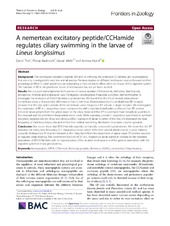| dc.description.abstract | Background The trochozoan excitatory peptide (EP) and its ortholog, the arthropod CCHamide, are neuropeptides that are only investigated in very few animal species. Previous studies on different trochozoan species focused on their physiological effect in adult specimens, demonstrating a myo-excitatory effect, often on tissues of the digestive system. The function of EP in the planktonic larvae of trochozoans has not yet been studied. Results We surveyed transcriptomes from species of various spiralian (Orthonectida, Nemertea, Brachiopoda, Entoprocta, Rotifera) and ecdysozoan taxa (Tardigrada, Onychophora, Priapulida, Loricifera, Nematomorpha) to investigate the evolution of EPs/CCHamides in protostomes. We found that the EPs of several pilidiophoran nemerteans show a characteristic difference in their C-terminus. Deorphanization of a pilidiophoran EP receptor showed, that the two splice variants of the nemertean Lineus longissimus EP activate a single receptor. We investigated the expression of EP in L. longissimus larvae and juveniles with customized antibodies and found that EP positive nerves in larvae project from the apical organ to the ciliary band and that EP is expressed more broadly in juveniles in the neuropil and the prominent longitudinal nerve cords. While exposing juvenile L. longissimus specimens to synthetic excitatory peptides did not show any obvious effect, exposure of larvae to either of the two EPs increased the beat frequency of their locomotory cilia and shifted their vertical swimming distribution in a water column upwards. Conclusion Our results show that EP/CCHamide peptides are broadly conserved in protostomes. We show that the EP increases the ciliary beat frequency of L. longissimus larvae, which shifts their vertical distribution in a water column upwards. Endogenous EP may be released at the ciliary band from the projections of apical organ EP positive neurons to regulate ciliary beating. This locomotory function of EP in L. longissimus larvae stands in contrast to the repeated association of EP/CCHamides with its myo-excitatory effect in adult trochozoans and the general association with the digestive system in many protostomes. | en_US |

